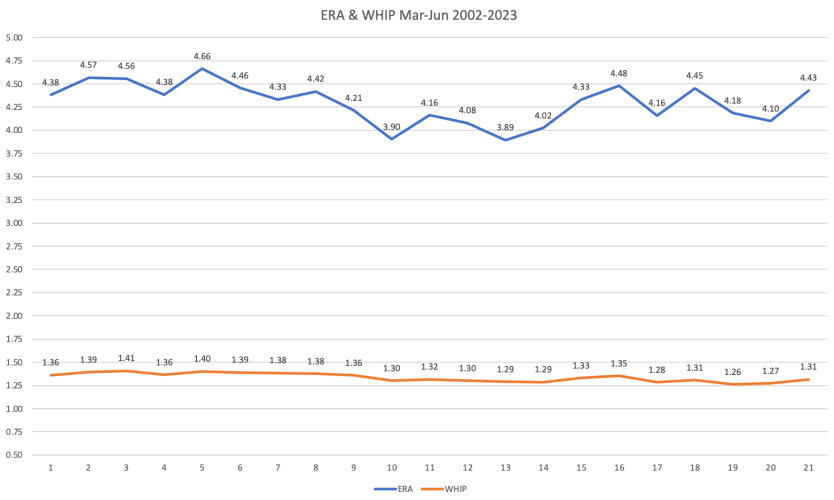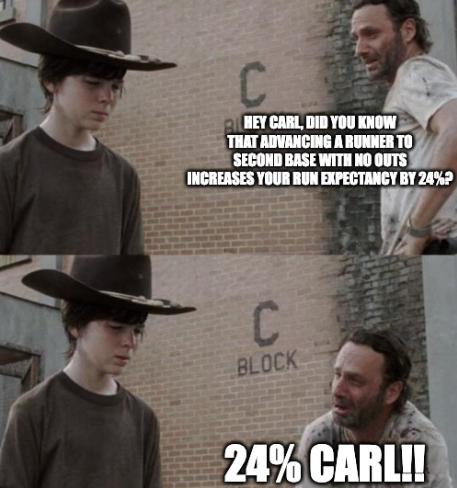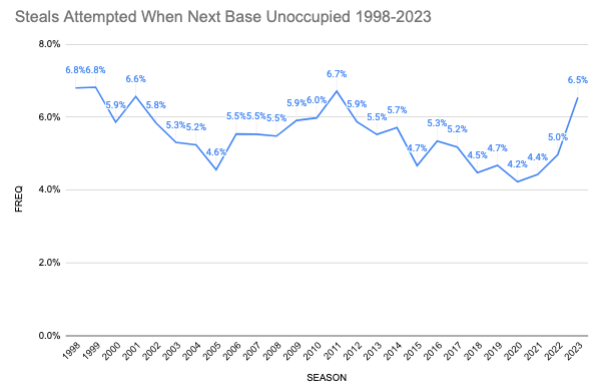The success of your 2023 fantasy team(s) has likely been impacted by starting pitching given the drastic changes we have seen in the early stanzas of the season this year. The league enters play on June 10th with a collective 4.43 ERA for starting pitchers along with a 1.36 WHIP. Let's start there, because one may assume that ERA is up because WHIP is up too. That is simply not the case.
Using the splits board at Fangraphs, I am able to isolate stats down to a month split over multiple seasons. The graph below shows ERA and WHIP since 2022, isolated to the months of March to June:

We have seen a 3.2 percent increase in the traffic on the bases in 2023 over 2022, and this year's WHIP is one of the three highest WHIPs in recent seasons. Meanwhile, starting pitcher ERA is up 8.0 percent over this time last year and is nearly identical to the levels we saw in early 2017 and 2019. Those two seasons saw introductions (allegedly) of two different versions of livelier baseballs. This season has seen the revitalization of the running game as teams are efforting to put more runners in scoring position. We are essentially seeing the Run Expectancy Matrix play out in real time, as teams saw from data just last season which showed that the likelihood of a leadoff runner who reached first scoring increased by 24 percent if that runner got to second with no outs.

The league
The success of your 2023 fantasy team(s) has likely been impacted by starting pitching given the drastic changes we have seen in the early stanzas of the season this year. The league enters play on June 10th with a collective 4.43 ERA for starting pitchers along with a 1.36 WHIP. Let's start there, because one may assume that ERA is up because WHIP is up too. That is simply not the case.
Using the splits board at Fangraphs, I am able to isolate stats down to a month split over multiple seasons. The graph below shows ERA and WHIP since 2022, isolated to the months of March to June:

We have seen a 3.2 percent increase in the traffic on the bases in 2023 over 2022, and this year's WHIP is one of the three highest WHIPs in recent seasons. Meanwhile, starting pitcher ERA is up 8.0 percent over this time last year and is nearly identical to the levels we saw in early 2017 and 2019. Those two seasons saw introductions (allegedly) of two different versions of livelier baseballs. This season has seen the revitalization of the running game as teams are efforting to put more runners in scoring position. We are essentially seeing the Run Expectancy Matrix play out in real time, as teams saw from data just last season which showed that the likelihood of a leadoff runner who reached first scoring increased by 24 percent if that runner got to second with no outs.

The league is already 52 percent of the way to eclipsing its 2022 stolen bases attempted, and 55 percent of the way to matching the number of successful steals. The league-wide stolen base success rate has averaged 80 percent this season with the league attempting stolen bases 6.5 percent of the time when the next base is unoccupied, a rate we haven't seen since the 2011 season:

This doesn't only apply to second base, as we're also seeing an increase in attempts to steal third, both from one runner as well as double steals. Last season saw the Yankees lead all of baseball in stealing third base, doing so 20 times in 26 attempts. Eight of the 30 teams had as many as 14 successful steals of third over the entirety of the 2022 season, while four teams have already reached that mark in 2023. The Rays and Pirates have each swiped third base 16 times while the Reds and Athletics have done so 14 times apiece. The league converted 294 of its 379 attempted steals of third base (77.5 percent) in 2022 but has spiked that up to 87.2 percent this season, succeeding in 205 of its 235 attempts. We honestly have to look no further than this issue to help understand while starting pitching ERA is higher than nearly everyone projected it to be this season.
Dylan Drummey of PitcherList did the dirty math in the aforelinked article for an updated Run Expectancy Matrix for recent years, and I have pulled that data from that article in the table below:
2016-2019, 2021 Aggregate Run Expectancy Matrix
On Base | 0 Out | 1 Outs | 2 Outs |
|---|---|---|---|
_ _ _ | 0.514 | 0.274 | 0.106 |
1 _ _ | 0.899 | 0.533 | 0.224 |
_ 2 _ | 1.147 | 0.688 | 0.323 |
_ _ 3 | 1.389 | 0.972 | 0.361 |
1 2 _ | 1.478 | 0.937 | 0.441 |
1 _ 3 | 1.774 | 1.188 | 0.488 |
_ 2 3 | 1.998 | 1.396 | 0.564 |
1 2 3 | 2.272 | 1.579 | 0.763 |
This is the data a club will look at as they decide whether to put runners in motion. It's by no means the sole determining factor, but it is the motivating factor as the managerial staff debates how much risk they are willing to assume in pursuit of increasing their chances of scoring. The league attempted 3,297 steals last year in their pursuit of increasing their scoring odds and has already done so 1,715 times this season. The league-wide stolen base success rate has improved by 6.7 percent year over year, which comes in just below the aforementioned 8 percent increase in starting pitching ERA. I would posit that difference could be explained by a combination of the pitch clock, the increased rate of injuries to quality starting pitching this season and the defensive positional changes.
In summary, I do not believe the worst is behind us, rather, this is the new reality of starting pitching until teams can accelerate their development of catchers with 1.6 pop times. Despite the changes in defensive positioning, we aren't seeing an increase of traffic on the bases as much as we are seeing more motion of the traffic on base. This ERA damage to our starting pitchers is simply the consequence of the league enticing teams to steal more bases by limiting how teams can defend the maneuver and increasing the size of the bases to shorten the distance between the two bases. Teams like to do what they are successful at, and as long as the league average for steals remains at 80 percent, there will be collateral damage to pitcher's ERAs. Even if the amount of base traffic is relatively normal, those baserunners have an increased chance of scoring. This is not a new era of baseball as much as a return to one that we have forgotten about, as we haven't seen a season in a long time where the running game was the predominant factor in the increase in scoring.


























